Podcast: Play in new window | Download
Subscribe: Apple Podcasts | RSS
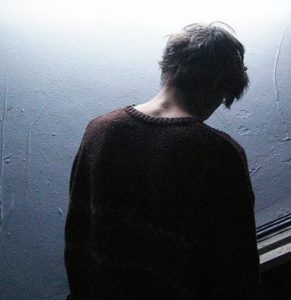 The state of Baja California Sur only became a state in Mexico in 1974. It occupies the lower half of the Baja Peninsula in the far western part of the country, on the Pacific coast. Like so many places in Mexico, Baja California Sur is home to many legends. Here are five.
The state of Baja California Sur only became a state in Mexico in 1974. It occupies the lower half of the Baja Peninsula in the far western part of the country, on the Pacific coast. Like so many places in Mexico, Baja California Sur is home to many legends. Here are five.
- The Boy with the Horrible Teeth
A shoemaker named Don Hipólito Escopinichi, lived in one of the oldest neighborhoods of La Paz, the capital of the state of Baja California Sur. One night when he was returning home from work, a child approached him out of nowhere and asked for money. He gave the child the requested coin at which point the boy smiled a ghoulish grin that showed off large and crooked teeth attached to bright red gums. Scared, the cobbler ran home feeling that he had seen a demon or ghost.
Days after the shoemaker’s encounter, a Municipal Police sergeant was heading to the south of the city at night, when he saw the figure of a little boy about a three feet tall walking alone on the side of the road. Knowing the legend, which had already spread throughout the city, he prepared to face the possibility of meeting this hideous apparition. It was when, after begging for a coin, that the boy showed his horrible cadaverous smile to the sergeant. The boy then let out a deep and sinister laugh that echoed through the night before running away into the darkness. The police officer died the following day of cardiac arrest.
There was no trace of this strange, otherworldly boy. However, the sightings continued with astonishing frequency. An elderly woman, who was returning home on foot from a local hospital in the El Esterito neighborhood, was intercepted by the boy. Full of terror, she fled at full speed through a dark street until a pack of wild dogs attacked her. A victim of the terrible dog bites, the woman passed away a few days later.
It was said that the entity that manifested in this horrible young boy seemed to come out of the quarry stone walls that surrounded a former citrus orchard that once belonged to the descendants of the Toledo family. Someone suggested the old stone wall be torn down, and so it was done on a chilly morning. The masons responsible for the demolition claimed to hear horrible sounds from among the stones of the crumbling wall. Over time, the legend was forgotten, and the boy was never heard from again.
- The Devil’s Pearl
To the southwest of San José Island in the Sea of Cortez, about 35 miles north of La Paz, there was a remote location that at the end of the 1800s was a favorite spot for pearl divers. Hundreds of 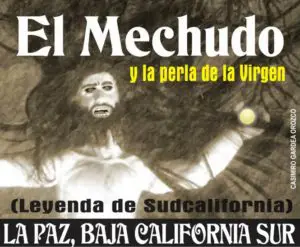 divers gathered there every year. At the end of each season, before the cold and the northwesterly winds made diving impossible, the divers used to take out one last pearl “for the Virgin Mary.” On one occasion, a diver was about to jump into the sea for the last time, when someone, noticing the attempt, yelled at him:
divers gathered there every year. At the end of each season, before the cold and the northwesterly winds made diving impossible, the divers used to take out one last pearl “for the Virgin Mary.” On one occasion, a diver was about to jump into the sea for the last time, when someone, noticing the attempt, yelled at him:
“Hey, stop diving. We already have the pearl for the Virgin.”
The diver made a gesture of disdain and replied mockingly: “I’m not going for the Virgin’s pearl, I’m going to find one for the Devil.”
And then he jumped into the water.
Satan took him at his word, and the diver did not reappear nor did the waters return his corpse. The place is now off limits and nobody goes there to look for pearls. Those who have dared, have found in those forbidden waters the ghost of the blasphemous diver, who has grown an enormous head of hair and a bearded tongue. He appears alive, and in his hands he holds a huge mother-of-pearl shell. Inside the shell is the pearl of the devil, they say. The ghost with long hair has been given the name of “El Mechudo” and that taboo place is now called Punta Cabeza Mechuda.
- The Long-Armed Woman in the Cemetery
In the thicket of a local cemetery in La Paz, hiding in the dark, lurks a woman of medium height, slim figure and dressed in black. Her name María Eugenia. According to what the stories say, this woman dressed in black is a kind of entity, a banshee or a demon. She takes the form of a human but with one difference: she has extra-long limbs. It is said that her face can never be seen.
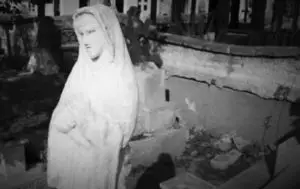 At first it was believed that this woman was the product of the imaginations of the people who visited the Cemetery of Los San Juanes in 1894, and therefore most people didn’t think much of the story. In 1974, a specter or shadow creature started appearing in the graveyard and some old timers remembered the story of María Eugenia. Many visitors to the cemetery experienced the exact same thing as was reported 80 years before: An angry, faceless female presence would appear, and this entity had very long arms. Those paying respects to deceased relatives in the cemetery would be scared or violently attacked. Witnesses also claimed that in the crypt where she was supposedly buried, María Eugenia’s screams and cries were so loud and blood-curdling that they were heard across the entire burial ground.
At first it was believed that this woman was the product of the imaginations of the people who visited the Cemetery of Los San Juanes in 1894, and therefore most people didn’t think much of the story. In 1974, a specter or shadow creature started appearing in the graveyard and some old timers remembered the story of María Eugenia. Many visitors to the cemetery experienced the exact same thing as was reported 80 years before: An angry, faceless female presence would appear, and this entity had very long arms. Those paying respects to deceased relatives in the cemetery would be scared or violently attacked. Witnesses also claimed that in the crypt where she was supposedly buried, María Eugenia’s screams and cries were so loud and blood-curdling that they were heard across the entire burial ground.
It is said that when María Eugenia makes her presence known she has the firm intention of taking those whom she encounters to the afterlife, being a bad omen for anyone who sees her. It is not by chance that the accounts of her appearances are very close to the news of the death of some people, and this is confirmed by some documents and newspapers of the time. Although not seen for decades, locals warn people to be careful when they visit the Los San Juanes Cemetery as the mysterious apparition of María Eugenia can stalk anyone.
- Welcome to the Hotel California
The Hotel California was founded in 1948 by a Chinese immigrant named Señor Wong. It is located in the town of Todos Santos, between La Paz and Los Cabos on the Pacific Ocean side of the Baja Peninsula.
Legend has it that Hotel California is the place where the spirit of a woman named Mercedes lives, offering wine to the lonely men who seek rooms for the night. According to the hotel, this legend supposedly inspired Don Henley and Glenn Frey to compose the famous song “Hotel California” released in 1977 and performed by the group The Eagles. According to the local Baja legend, Don 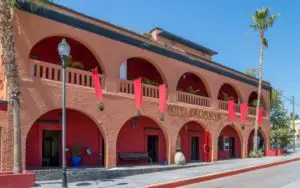 Henley supposedly stayed at that hotel. The official story of the creation of the song, however, claims that the “Hotel California” in the lyrics really refers to the Beverly Hills Hotel, where Henley and Frey spent a lot of time in the early and mid-1970s. People who subscribe to the Baja legend reference the lyrics that give the song a distinctively Mexican setting, including the sound of mission bells, the desert highway and “the smell of colitas,” which is a Mexican slang term for marijuana cigarettes. Eagles band members have stated publicly that the original working title of the “Hotel California” song was “Mexican Reggae.” There is also a mention of “Mercedes Benz” in the song which may indicate a tip of the hat to the hotel’s resident ghost, the wine-giving Mercedes. While the official interpretation of the song explains that the Hotel California is a symbolic representation of American materialism, others believe that the song is directly tied to the legend of the temptress phantom of the hotel in Todos Santos. Once Mercedes has you in her clutches, you can never leave, along with all the other guests she has lured to their demise. The woman is so beautiful in the song, standing in the doorway, that the singer wonders if he is in heaven or in hell.
Henley supposedly stayed at that hotel. The official story of the creation of the song, however, claims that the “Hotel California” in the lyrics really refers to the Beverly Hills Hotel, where Henley and Frey spent a lot of time in the early and mid-1970s. People who subscribe to the Baja legend reference the lyrics that give the song a distinctively Mexican setting, including the sound of mission bells, the desert highway and “the smell of colitas,” which is a Mexican slang term for marijuana cigarettes. Eagles band members have stated publicly that the original working title of the “Hotel California” song was “Mexican Reggae.” There is also a mention of “Mercedes Benz” in the song which may indicate a tip of the hat to the hotel’s resident ghost, the wine-giving Mercedes. While the official interpretation of the song explains that the Hotel California is a symbolic representation of American materialism, others believe that the song is directly tied to the legend of the temptress phantom of the hotel in Todos Santos. Once Mercedes has you in her clutches, you can never leave, along with all the other guests she has lured to their demise. The woman is so beautiful in the song, standing in the doorway, that the singer wonders if he is in heaven or in hell.
Some people claim that the owners of the hotel made up the story of Mercedes after the Eagles’ song became a worldwide number one hit. Others claim that the hotel has been haunted by a female ghost from at least the 1950s which would pre-date the song by some twenty years. Whether this is just a publicity stunt by opportunistic hotel owners or if this is a real ghostly presence that inspired a popular song may never be known.
- Cabo San Lucas, a City Forever Cursed
Sometime in the 1800s when Baja California was still a Mexican territory and Cabo San Lucas was a sparsely populated backwater port, a boat arrived at the town’s docks. The boat was full of yellow fever patients who days before had been in La Paz, where they were denied entry into port. When this ship arrived at the docks of Cabo San Lucas, those present on shore noticed the paleness and general sickly appearance of the people on the boat. The dock officials denied them entry.
It was one of those hot days and feeble woman came out from inside the boat, showing how sick she was by staggering across the deck. In her arms she was carrying a child and the only thing the woman and the crew of this ship asked of those present on shore was for a little water and food. Arguments ensued with no happy medium reached. They were so annoyed by the behavior of the passengers on the ship, not only did the people on the docks deny the ship any supplies, but they also threw water and food into the sea and then laughed mockingly.
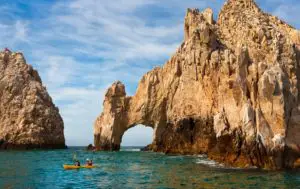 This act made the people on the boat even more angry. The passengers on the ship were mostly from Hungary and some of them were gypsies. An older woman dressed in colorful gypsy clothing leaned over the side of the ship and began yelling at those on shore. She cursed all the generations of those who were present on the dock and condemned them all to horrible deaths. This woman even cursed the entire port of Cabo San Lucas saying that one day it would disappear underneath the sea in a dramatic natural disaster. Following this loud and intense curse, the ship sailed away.
This act made the people on the boat even more angry. The passengers on the ship were mostly from Hungary and some of them were gypsies. An older woman dressed in colorful gypsy clothing leaned over the side of the ship and began yelling at those on shore. She cursed all the generations of those who were present on the dock and condemned them all to horrible deaths. This woman even cursed the entire port of Cabo San Lucas saying that one day it would disappear underneath the sea in a dramatic natural disaster. Following this loud and intense curse, the ship sailed away.
According to the legend a man named Thomas Ritchie, who was either an English or American businessman living in Cabo, arrived at the dock right after the commotion. When he saw that the ship was leaving, he wondered what was happening. After finding out about the sad state of the sick people onboard, he sent two people he trusted out in a small boat to bring the ship back to port since he could provide them with what they needed. However, when the small boat approached the ship, the boat full of sick passengers refused to return, insisting that if they set foot on land at Cabo San Lucas the curse could apply to them as well.
This story appears in the diaries and letters written in the late 1800s by some families that lived in Todos Santos and La Paz, so some believe this legend is tied to a real historical event. Since the time of the fever ship Cabo San Lucas has grown into a prime international tourist destination. The old gypsy’s curse still hangs over the city, however, so you might want to postpone or cancel your plans for a vacation there.
REFERENCES
Gracias to the ParaTodoMexico website for all their legends about Mexico

2 thoughts on “Legends of Baja California Sur”
Good ones, Robert!
Thanks!